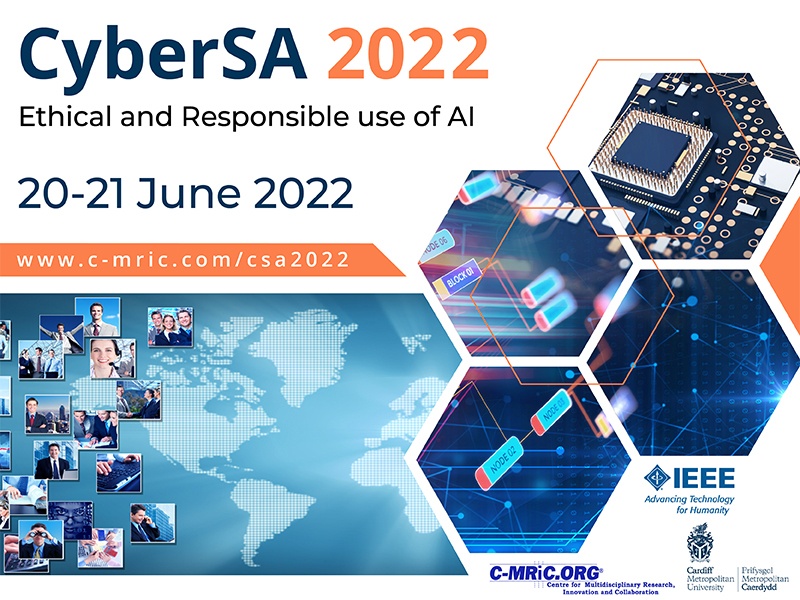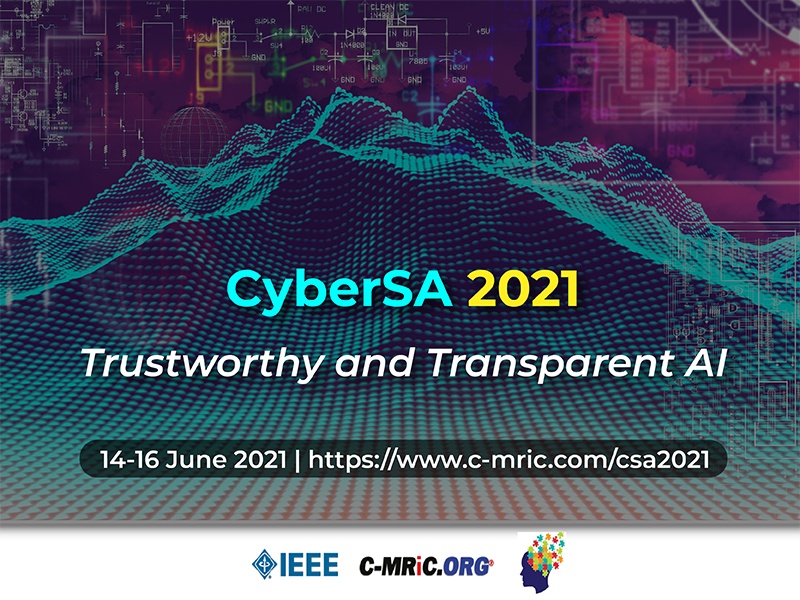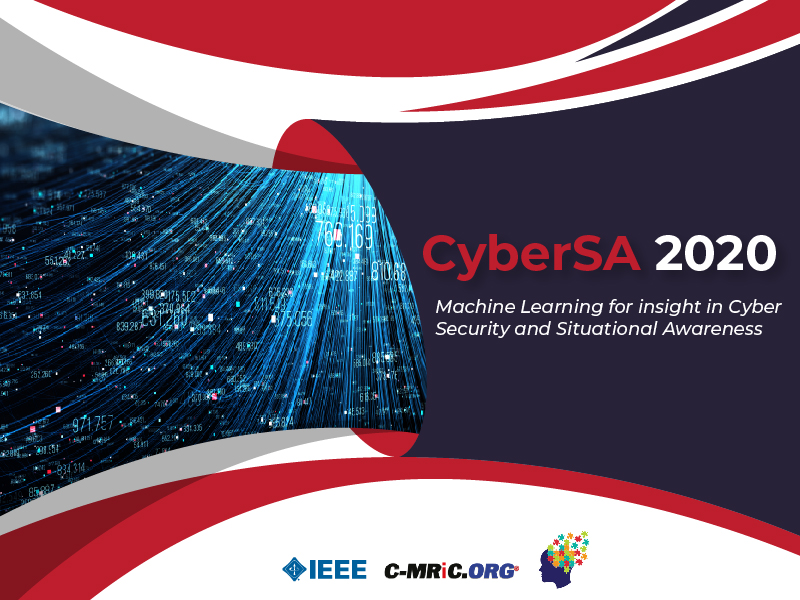
Theme – Cyber Situational Awareness for Predictive Insight and Deep Learning
Call for papers is closed!
Download a copy of the Event Programme
Download a copy of the Event Timetable
Call for Papers
IEEE is the Technical Co-Sponsor (TCS) of the International Conference on Cyber Situational Awareness, Data Analytics and Assessment (CyberSA 2019), an international refereed conference dedicated to the advancement of the principles, methods and applications of situation awareness on Cyber Systems, Business Information Systems (BIS), Computer Network Defence (CND), Critical National Infrastructures (CNI), Cyber Physical Systems (CPS) and Internet of Things (IoTs).
The aim of the CyberSA 2019 is to encourage participation and promotion of collaborative scientific, industrial and academic inter-workings among individual researchers, practitioners, members of existing associations, academia, standardisation bodies, and including government departments and agencies. The purpose is to build bridges between academia and industry, and to encourage interplay of different cultures.
CyberSA 2019 invites researchers and industry practitioners to submit papers that encompass principles, analysis, design, methods and applications. All submitted papers are independently peer-reviewed.
The conference proceedings will be submitted for consideration for publishing and listing on the following bibliographic indexes: IEEE Computer Society Digital Library, IEEE Xplore Digital Library, DBLP Computer Science, Scopus, CiteSeerX, Computer Science Index, EI Compendex, Academic Search Complete, CiteULike, Google Scholar & Microsoft Academic Search.
The organisers will accept registration of up to 5 IEEE UK&I Student and YP Members at 75% discounted rate, and will offer up to 20% registration discounts for all IEEE, BCS, IET & IISP members.
Details
CyberSA 2019, in conjunction with the International Workshop on Cyber Insurance and Risk Controls (CIRC 2019), is co-located with other conferences as part of Cyber Science 2019.
- Workshop on Cyber Insurance and Risk Controls (CIRC 2019) will be presented at the conference.
- Posters & Presentations will be presented at the conference.
- Industry track is available for discussing and publishing pilot and proof of concepts.
- Work in Progress track is available for preliminary work.
- Research Ideas track is available for ideas in early stages assessment.
- PhD Seminar track is available for discussing and publishing early PhD thesis research.
BOOK NOW
Paper Submission
The deadline for all paper submissions, that is, both full papers and extended abstracts for Poster, WIP, PoC, Research Idea and PhD Seminar presentations was 26th January 2019, but now extended to 28th February 2019.
All Industry track, Work in Progress track, Research Ideas track and PhD Seminar track will be published in the conference proceedings. Interested participants, please submit your proposal using the online submission system hosted by Easychair Conference Portal.
Full paper submission should be via Easychair Conference Portal.
Online Submission
The online submission process is now open!
Please prepare your paper according to the formatting guidelines (Word document/PDF template/LaTeX). Use the IEEE A4 paper type. Please note that it’ll be IEEE e-copyright, which must be completed for all accepted papers. We’ll send authors’ of accepted papers instruction on how to complete an IEEE e-copyright form.
Authors must use the online submission systems hosted by EasyChair Conference System to submit their papers. Please use/download the IEEE A4 paper template, and specify which conference your submission is to. If you don’t have an EasyChair account you will need to create one and then login in order to submit your papers. Please read the Submission Instructions before submitting your work in the system.
Submission Instructions
Both long (8 pages max., roughly 8,000 words) and short (4 pages max., roughly 4,000 words) paper submissions should be written in English and be submitted electronically via the EasyChair conference portal. Submission file formats are PDF and Microsoft Word using the IEEE A4 Paper template that can be found at the corresponding C-MRiC website. Authors wishing to present a Poster, Industry Proof of Concept (PoC), Work in Progress (WIP), Research Ideas, or PhD Seminar may submit a 2‐page extended abstract using the online submission systems hosted by EasyChair Conference System, which, if accepted, will appear in the conference proceedings.
Topics of Interest
- Situation Awareness in Software Defined Networks
- Security Monitoring, Scale of Things and Limits to Monitoring
- Block Chain Technology in Security
- IoT Detection and Software Driven Applications Security
- Situation Awareness in Mobile Computing
- Standardisation of Cyber Situation Awareness
- Search, Triage, Examination and Forensics in Cloud Computing
- Cyber SA in Chaotic Computing
- Cyber SA in Large Scale IDS Deployments
- Cyber SA in Deep Learning
- Cyber SA in Deep Analytics
- Machine Learning for Cyber Situational Awareness
- Assessment models and methodologies for Cyber SA
- Cyber Situation Awareness Evaluation Recommendation
- Cyber SA Maturity Models and Frameworks
- Cyber SA for Social Networks
- Social Network Interaction and Intelligence
- Web Analytics & Security Incident Response
- Organised and collaborative Maps and Networks
- Cyber Behavioural Analytics and Profiling
- Collaborative Situation Awareness for Decision Making
- Situation Assessment & Decision Making
- Defense Strategy for the Enhancement of Situation Awareness
- Situation Assessment, Resolution and Decision Loop
- Individual vs. Team SA
- Group and Team SA
- Trust, Privacy and Anonymity Issues
- Digital Forensic Information Analysis
- Enterprise Information Security Policies, Standards and Procedures
- Risks posed by Wireless Networks, including through the use of Mobile Computing, BYOD, Wearable in CND environment
- Fuzzy Logic
- Rough Set
- Artificial Neural Networks
- Artificial Intelligence
- Genetic Algorithm
- Evidence Theory (DST)
- Bayesian Networks & Set Theory
- Big Data Analytics
- Game Theory
- Graph Theory
- Cyber Attack Scenarios
- Situation-Aware and Context-Aware Network Applications
- CERTs and CSIRTs
- Security Event and Information Management
- Application Security, Audits and Penetration Testing
- Workload
- Perception
- Stress
- Knowledge
- Training and Expertise
- Risk Assessment and Decision Making
- Forecasting and Prediction
- Operator SA & Team SA
- Knowledge, Skills and Abilities (KSA)
- Information Security
- Cyber Security
- Database Security
- Application Security
- Law Enforcement and Surveillance
- Border Protection and Controls
- Cyber Warfare and Counter Terrorism
- Military Doctrinal in Situation Awareness
- C4ISR (Command, Control, Communications, Computers, Intelligence, Surveillance and Reconnaissance)
- Computer Network Operations
- Computer Network Defense
- Mission Awareness, Command and Control
- Attack Graphs
- Advanced Security Incident Analysis
- Sensor Correlation and Cross-Correlation
- Implementing Situation Awareness Systems
- Information Security Metrics and Measurements
- Proactive Defense Strategies
- Instance-Based Learning
- Adaptive Neural Logic
- Human-Assisted Decision Control
- Human in the Loop
- Automated Self-Responder
- Tools for Metric Optimisation
- Visualisation and Digital Analytics
- Data Mining
- Filtration, Selection, and Risk-Based Prioritisation
- Metrics for Evaluation and Assessment
- Usefulness of Multisensor Data Fusion
- Information Data Fusion
- Sensor Fusion for Security Incident Analysis
- Security Incident Analysis
- Data Association & Correlation
- Security Information Visualisation
- Data Analytics
- Security Monitoring
- Situation Awareness in C4ISR
- Situation Awareness in Cyber Command and Control Centres
- Situation Awareness in Intrusion Defense
- Situation Awareness in Cyber Physical Systems (CPS)
- Situation Awareness for Internet of Things (IoTs), Enterprise Internet of Things (EIoTs)
- Open Source Applications
- Functional Requirements for Situation-aware services
- Non-Functional Requirements for Situation-aware Services and solutions
- Interface Design
- Interoperability
- Dynamism
- Complexity
- Performance
- Automation
- Responsiveness
- Architecture
- Realtime Processing
- Synchronisation
- Research and development in Situation Awareness
- Simulation and Testbeds in Cyber Situation Awareness
- Experimentation & Instrumentation
- Modelling
- Knowledge-base
- Theoretical Underpinnings in Situation Awareness
- Team and Group SA
- Cyber Situation Awareness Methods, Training and Education
Speakers

Important Dates
- Industry (Proof of Concept / Pilot) Submission –
January 26, 2019, extended February 28, 2019 - Extended Abstract (Work in Progress) –
January 26, 2019, extended February 28, 2019 - PhD Seminar Submissions –
January 26, 2019, extended February 28, 2019 - Research Ideas –
January 26, 2019, extended February 28, 2019 - Poster/Demo Submissions –
January 26, 2019, extended February 28, 2019 - Special Track Submissions –
January 26, 2019, extended February 28, 2019 - Workshops and Tutorials Submission –
January 26, 2019, extended February 28, 2019 - Full Paper Submissions –
January 26, 2019, extended February 28, 2019 - Notification of Full Paper/Abstract / Special Track Acceptance/Rejection – March 26, 2019
- Camera Ready Paper Due – April 14, 2019
- Participants Registration – March 26 – May 6, 2019
- Conference Date – June 3 – 4, 2019
Location
University of Oxford
Department of Computer Science
University of Oxford
Wolfson Building
Parks Road, Oxford OX1 3QD
United Kingdom
Programme Committee
- Cyril Onwubiko – Centre for Multidisciplinary Research, Innovation and Collaboration, UK
- Frank Wang – IEEE, United Kingdom and Ireland
- Arnau Erola – Cyber Security Centre, Department of Computer Science, University of Oxford, Oxford, UK
- Virginia Franqueira – Cyber Security, University of Derby, UK
- Fatih Kurugollu – Cyber Security, University of Derby, UK
- Janne Merete Hagen – Norwegian Defence Research Establishment, Norway
- Xavier Bellekens – University of Abertay, Dundee, Scotland, UK
- Arnau Erola – Department of Computer Science, University of Oxford, UK
- Virginia Franqueira – Cyber Security, University of Derby, UK
- Fatih Kurugollu – Cyber Security, University of Derby, UK
- Xavier Bellekens – University of Abertay, Dundee, Scotland, UK
- Zeyad Yousif Al-Shibaany – IEEE UK and Ireland, EAO Chair
- Thaddeus Eze – IEEE UK and Ireland YP & Department of Computer Science, University of Chester, UK
- Nazila Fough – IEEE UK and Ireland Young Professionals (IEEE YP) & Robert Gordon University of Aberdeen, Scotland, UK
- Hanan Hindy – University of Abertay, Dundee, Scotland, UK
- Frank Wang – IEEE Computer Society, UK & Ireland
- Natalie Coull – University of Abertay, Dundee, Scotland, UK
- Uri Blumenthal – MIT Lincoln Laboratory, MIT, USA
- Xavier Bellekens – University of Abertay, Scotland, UK
- Virginia Franqueira – Cyber Security, University of Derby, UK
- Fatih Kurugollu – Cyber Security, University of Derby, UK
- Sotiris Ioannidis – the Institute of Computer Science, Foundation for Research and Technology (FORTH), Greece
- Phil Legg – University of the West of England, UK
- Kevin Curran – Faculty of Computing and Engineering, Ulster University, Northern Ireland, UK
- Jussi Timonen – The Finnish Defence Research Agency, Finland
- Xavier Bellekens – University of Abertay, Scotland, UK
- Cyril Onwubiko – Centre for Multidisciplinary Research, Innovation and Collaboration, UK
- Virginia Franqueira – Cyber Security, University of Derby, UK
- Fatih Kurugollu – Cyber Security, University of Derby, UK
- Timothy O’Farrell – Department of Electronic and Electrical Engineering, The University of Sheffield, UK
- Thomas Pasquier – Department of Computer Science, University of Bristol, UK
- Francisco J Aparicio Navarro, Cyber Technology Institute, School of Computer Science and Informatics, Faculty of Computing, Engineering and Media, De Montfort University, UK
- Fabio Roli – Pattern Recognition and Applications Lab, University of Cagliari, Italy
- Arnau Erola – Cyber Security Centre, University of Oxford, Oxford, UK
- Jassim Happa – Cyber Security Centre, Department of Computer Science, University of Oxford, Oxford, UK
- Jorge Varela Barreras – Oxford Research Staff Society Engineering Science, University of Oxford, UK
- Mansour Alsaleh – Research Fellow at MIT
- Aunshul Rege – Temple University, Pennsylvania, USA
- Artsiom Yautsiukhin – National Research Council, Italy
- Dimitrios Papamartzivanos – University of the Aegean, Greece
- Jussi Timonen – The Finnish Defence Research Agency, Finland
- Roman Graf – Austrian Institute of Technology (AIT), Austria
- Andrea Cullen – Director of Cyber Security Interdisciplinary Centre, University of Bradford, UK
- Lynsay Shepherd – Abertay University, Scotland, UK
- Fatih Kurugollu – Cyber Security, University of Derby, Derby, UK
- Amin Hosseinian-Far – Faculty of Arts, Environment & Technology, Leeds Beckett University, Leeds, UK
- Kevin Curran – Faculty of Computing and Engineering, Ulster University, Northern Ireland, UK
- Eliana Stavrou – Computing Department, UCLan Cyprus, Larnaca, Cyprus
- Pierre Parrend – ECAM Strasbourg-Europe, France
- Uwe Glässer – School of Computing Science, Simon Fraser University, Canada
- Stacy J. Prowell – U.S. Department for Energy (DOE-OE) Cybersecurity for Energy, USA
- Jens Myrup Pedersen – University of Aalborg, Denmark
- Marios Anagnostopoulos – University of the Aegean, Greeceb
- Uri Blumenthal – MIT Lincoln Laboratory, MIT, USA
- Ciza Thomas – College of Engineering, India
- Stefanos Gritzalis – University of the Aegean, Greece
- Varun Dutt – Indian Institute of Technology Mandi, India
- Georgios Kambourakis – University of the Aegean, Greece
- Elisavet Konstantinou – University of the Aegean, Greece
- Panagiotis Trimintzios – Cyber Crisis Cooperation & Exercises Team Operational Security, ENISA, Europe
- Phil Legg – University of the West of England, UK
- Huiyu Zhou – Queen’s University Belfast, Belfast, UK
- Jason Nurse – University of Kent, UK
- Per Hakon Meland – SINTEF, Norway
- Martin Gilje Jaatun – University of Stavanger, Norway
- Petra Leimich – Edinburgh Napier University, Edinburgh, Scotland, UK
- Boniface K. Alese – Department of Computer Science, Federal University of Technology, Akure, Nigeria
- Keeley Crockett – IEEE Women in Engineering & School of Computing, Maths and Digital Technology, Manchester Metropolitan University, UK
- Ensar Seker – NATO, CCD COE, Estonia
- Logan Mailloux – European Office of Aerospace Research and Development, US Air Force, USAF, USA
- Martin Span – Systems Engineering, US Air Force Academy, USAF, USA
- Erin Kenneally – Cyber Security Division, Science and Technology Directorate, Department of Homeland Security, USA
- Christopher D. McDermott – School of Computing Science and Digital Media, Robert Gordon University, Scotland, UK
- Ulrik Franke – Software and Systems Engineering Laboratory (SSE), RI.SE, Sweden
- Michal Chorasm – Telecommunications and Computer Science, University of Science and Technology (UTP), Bydgoszcz, Poland
Conference Programme
Download a copy of the Conference Programme
- Jonah Burgess, Domhnall Carlin, Philip O’Kane and Sakir Sezer. MANiC: Multi-step Assessment for Crypto-miners
- Alan Mills, Theodoros Spyridopoulos and Phil Legg. Efficient and Interpretable Real-Time Malware Detection Using Random-Forest
- Peyman Kabiri and Mahdieh Chavoshi. Destructive Attacks Detection and Response System for Physical Devices in Cyber-Physical Systems
- Bernhardt Engerer and Alexiei Dingli. Big Social Data – Predicting Users’ Interests from their Social Networking Activities
- Chunlei Li, Chunming Rong and Martin Gilje Jaatun. A cost-efficient scheme for Bitcoin-like blockchain
- Kimberly Tam and Kevin Jones. Forensic Readiness within the Maritime Sector
- Kimberly Tam and Kevin Jones. Factors Affecting Cyber Risk in Maritime
- Yogesh Patel, Karim Ouazzane, Vassil Vassilev, Ibrahim Faruqi and George Walker. Keystroke Dynamics using Auto Encoders
- Theo Lynn, Patricia Takako Endo, Pierangelo Rosati, Ivanovitch Silva, Guto Leoni and Debbie Ging. Detecting Hate Speech Online: A
- Comparison of Machine Learning Approaches for Automatic Misogyny Detection in Urban Dictionary
- Aunshul Rege and Scott Vanzant. Examining the Roles of Muhajirahs in the Islamic State via Twitter
- Olivier Jacq, David Brosset, Yvon Kermarrec and Jacques Simonin. Cyber attacks real time detection: towards a Cyber Situational Awareness for naval systems
- Cyril Onwubiko and Karim Ouazzane. Cyber Onboarding is ‘Broken’
- Meha Shukla, Shane Johnson and Peter Jones. Does the NIS implementation strategy effectively address cyber security risks in the UK?
- Erik Moore, Steven Fulton, Roberta Mancuso, Tristen Amador and Dan Likarish. Collaborative Training and Response Communities – An Alternative to Traditional Cyber Defense Escalation
- Andrew Mason, Yifan Zhao, Hongmei He, Raymon Gompelman, Srikanth Mandava and Guy Adams. Online Anomaly Detection of Time Series at Scale
- Yuanyuan Zhu, Mee Chi So and Paul Harrigan. Domain Identification for Commercial Intention-holding Posts on Twitter
- Leonard Renners, Felix Heine, Carsten Kleiner and Gabi Dreo. Adaptive and Intelligible Prioritization for Network Security Incidents
- Thomas Daniel Wagner. Cyber Threat Intelligence for “Things”
- Eszter Oroszi. Security awareness escape room – a possible new method in improving security awareness of users
- Wenjun Xiong and Robert Lagerström. Threat Modeling of Connected Vehicles: A privacy analysis and extension of vehicleLang
- Subhi Alrubei, Jonathan Rigelsford, Callum Willis and Edward Ball. Ethereum Blockchain for Securing the Internet of Things: Practical Implementation and Performance Evaluation
- Muntaha Saleem. Brexit Impact on Cyber Security of United Kingdom
- Nima Asadi, Aunshul Rege and Zoran Obradovic. Pattern discovery in intrusion chains and adversarial movement
- Yuxiang Hong and Steven Furnell. Organizational formalization and employee information security behavioral intentions based on an extended TPB model
- Christopher McDermott and John Isaacs. Towards a Conversational Agent for Threat Detection in the Internet of Things
- Kamalakanta Sethi, Ankit Pradhan, Punith. R and Padmalochan Bera. A Scalable Attribute Based Encryption for Secure Data Storage and Access in Cloud
- Aunshul Rege, Katorah Williams and Alyssa Mendlein. A Social Engineering Course Project for Undergraduate Students Across Multiple Disciplines
- Yunjia Wang and Ishbel Duncan. A Novel Method to Prevent Phishing by using OCR Technology
- Chern Nam Yap, Rui Tao Kee, Jovan Sie and Rhys Wong. Arithmetic Circuit Homomorphic Encryption and Multiprocessing Enhancements
- Mahin Talukder, Syed Islam and Paolo Falcarin. Analysis of Obfuscated Code with Program Slicing
- Pranshu Bajpai, Tyler Olsen, Seth Edgar, Rob McCurdy and Richard Enbody. BATSense: Anomalous Security Event Detection using TBATS Machine Learning
- Mary C. (Kay) Michel and Michael C. King. The Future of Cyber Analytics: Identity Classification for Systematic and Predictive Insight
- Zirak Allaf, Mo Adda and Alexandar Gegov. TrapMP: Malicious Process Detection By Utilising Program Phase Detection
- Marios Ioannou, Eliana Stavrou and Maria Bada. Cybersecurity Culture in Computer Security Incident Response Teams: Investigating difficulties in communication and coordination
- Florian Skopik and Stefan Filip. Design principles for national cyber security sensor networks: Lessons learned from small-scale demonstrators
- Phil Legg and Tim Blackman. Tools and Techniques for Improving Cyber Situational Awareness of Targeted Phishing Attacks
- Martin Lundgren and Erik Bergström. Security-Related Stress: A Perspective on Information Security Risk Management
- Sikha Bagui, Debarghya Nandi, Subhash Bagui and Robert Jamie White. Classifying Phishing Email Using Machine Learning and Deep Learning
- Fiona Carroll, Phil Legg and Adam Chakof. What makes for effective visualisation in Cyber Situational Awareness for Non-Expert Users?
- Jd Work. In wolf’s clothing: Complications of threat emulation in contemporary cyber intelligence practice
- Belqassim Bouteghrine, Mohammed Rabiai, Camel Tanougast and Said Sadoudi. Hardware Implementation of Secured Socket Communication based on Chaotic Cryptosystem
- Renate Schubert and Ioana Marinica. Facebook Data: Sharing, Caring, and Selling
- Wenting Li, Haibo Cheng and Ping Wang. Secure Chaotic Maps-based Authentication Scheme for Real-Time Data Access In Internet of Things
- Suleiman Yerima and Sarmadullah Khan. Longitudinal performance analysis of machine learning based Android malware detectors
- Cyril Onwubiko and Austine Onwubiko. Cyber KPI for Return on Security Investment
- Aguinaldo Bezerra, Gisliany Alves, Ivanovitch Silva, Pierangelo Rosati, Patricia Takako Endo and Theo Lynn. A Preliminary Exploration of Uber Data as an Indicator of Urban Liveability
- Kamalakanta Sethi, Rahul Kumar, Lingaraj Sethi, Padmalochan Bera and Prashanta Kumar Patra. A Novel Machine Learning Based Malware Detection and Classification Framework
- Lakshmi Prayaga. Empowering Citizen data Scientists
- Adam Zibak and Andrew Simpson. Towards Better Understanding of Cyber Security Information Sharing
- Abraham Althonayan and Alina Andronache. Resiliency under Strategic Foresight: The effects of Cybersecurity Management and Enterprise Risk Management alignment
- Remy Zgraggen. Cyber Security Supervision in the Insurance Sector: Smart Contracts and Chosen Issues
- William Claycomb and Daniel Costa. Poster: Leveraging Existing IT Resources for Insider Threat Risk Mitigation
- William Claycomb and Daniel Costa. Poster: Indicator Development for Insider Threat Risk
- Adrian Duncan, Sadie Creese and Michael Goldsmith. A Combined Attack-Tree and Kill-Chain Approach to Designing Attack-Detection Strategies for Malicious Insiders in Cloud Computing
- Ferenc Leitold. Practical approach for maesuring the level of user behavior
- Bertrand Venard. The determinants of individual cyber security behaviours
Related Conferences:

Social Media 2019
IEEE is the Technical Co-Sponsor (TCS) of the International Conference on Social Media, Wearable and Web Analytics (Social Media 2019).
View More
Cyber Security 2019
IEEE is the Technical Co-Sponsor (TCS) of the International Conference on Cyber Security and Protection of Digital Services (Cyber Security 2019).
View More
Cyber Incident 2019
IEEE is the Technical Co-Sponsor (TCS) of the International Conference on Cyber Incident Response, Coordination, Containment & Control (Cyber Incident 2019).
View More







